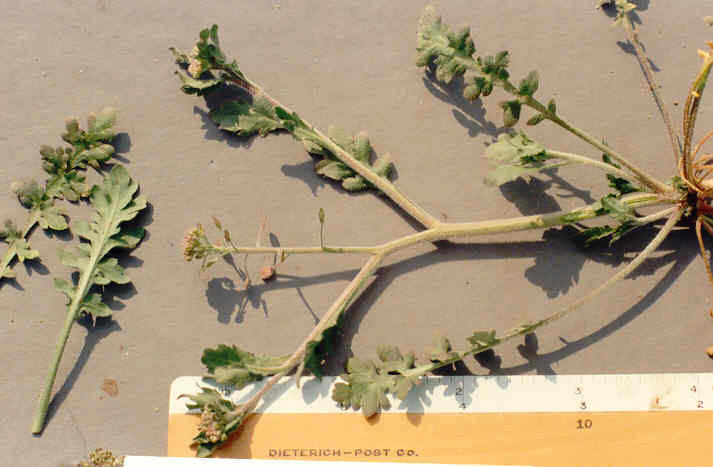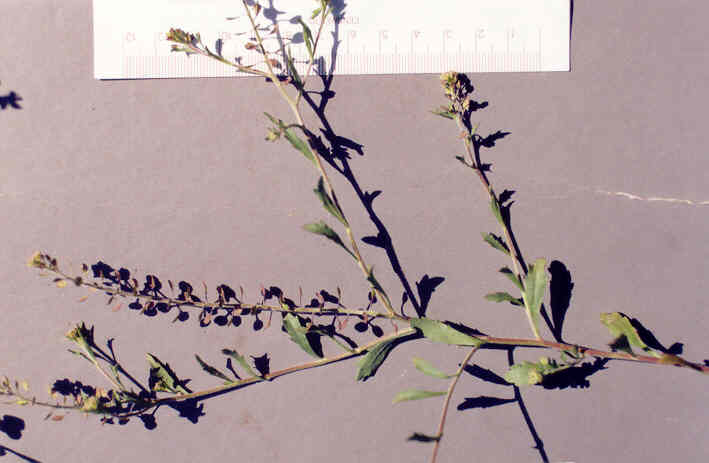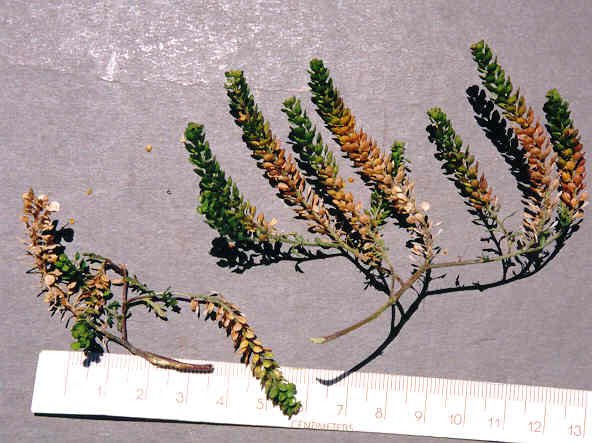
Lepidium lasiocarpum var. lasiocarpum Torrey & A. Gray
Brassicaceae (Mustard Family)
Native
 |
Lepidium lasiocarpum var. lasiocarpum Torrey & A. GrayBrassicaceae (Mustard Family)
Native
Sand Peppercress |
Plant Characteristics:
Branched spreading annual, the branches .5-2.5 dm. long, hirsute-hispid;
leaves linear to oblanceolate, toothed to pinnatifid, l-2 cm. long or the lower
to 6 cm. long and petioled; racemes 3-8 cm. long; pedicels distinctly flattened
on both surfaces, 2-5 mm. long, usually pubescent on lower side; sepals about 1
mm. long; petals narrow, usually shorter than sepals or 0; stamens 2,4 or 6;
silicles subglabrous to hispid, suborbicular to somewhat longer than wide, 3-4.5
mm. wide, finely reticulate, slightly winged at apex, with notch less than
one-fifth the length of the fr.
Habitat:
Common on grassy slopes and sandy flats, below 5000 ft.; Creosote Bush
Scrub, Shadscale Scrub, deserts from Inyo Co. to Imperial Co., less frequent in
cismontane Calif. in Coastal Sage Scrub, V. Grassland, etc. from Santa Barbara
Co. south; Arizona, Baja CA, to Colorado. Feb-May.
Hickman, Ed. 429, lists the species as growing below 600 m., not the 5000
ft. described in Munz, Flora So. Calif.
294.
Name:
Greek, lepidion, a little
scale, from shape of pods. (Munz, Flora
So. Calif. 291). Greek, lasios, hairy and karpos,
fruit. (Jaeger 47,137).
Species name refers to the hispid fruit.
General:
Uncommon in the study area, having only been found on the Castaway's
bluffs prior to 1989. In the summer
of 1988 an area of approximately 10 acres on the westerly side of the Delhi
ditch burned. Observations in the
spring of 1989, a very dry year, showed three species that had not previously
been found in the area, these are: Camissonia
bistorta, Calandrinia ciliata var.
menziesii and Lepidium lasiocarpum.
Photographed on the Castaway's Bluffs.
(my comments). The leaves vary considerably in size and shape with the
cauline ranging from subentire and small, to much larger, oblanceolate and
pinnatifid with broad divisions. Note
the variation in the pictures.
(my further comments). Seeds of all species mixed with
vinegar and a little salt make an excellent dressing for meat.
The seeds may be used directly as flavoring in salads, soups and stews,
and are nutritious. The young
shoots of the plants are good in salads. (Kirk,
37). The
1993 Jepson Manual describes L.
lasiocarpum
var. lasiocarpum while Munz, Flora So.
Calif. describes only L.
lasiocarpum. In the
spring of 1994, I confirmed that these are the same plant. (my comment).
About 130 species, widely distributed; one grown for salad. (Munz, Flora So. Calif.
291). L. apetalum, is recommended as a hair tonic in combination with
sage, henna leaves and chinchona bark. (Meyer
93).
Text Ref:
Hickman, Ed. 429; Munz, Calif. Flora 22; Munz, Flora
So. Calif. 294; Roberts 16.
Photo Ref: Feb 1 85 # 13A,14A; March-April 00 #17; April-May 05 #15.
Identity: by R. De Ruff, confirmed by F. Roberts.
First Found: February 1985.
Computer Ref: Plant Data 8.
Have plant specimen.
Last edit 6/12/05.
 |
 |
April Photo May Photo